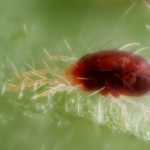
Research Summary Abstract
From 1999 to 2016, 34 active ingredients were tested mainly as foliar applications against several genera and species of mite pests on ornamentals and vegetables. Mite species tested included: broad mite, Polyphagotarsonemus latus, Eriophyid mites including Aceria sp., Aculops lycopersici, Aculus ligustri, Aculus schlechtendali, Epitrimerus pyri, spider mites including Tetranychus urticae, Oligonychus ilicis and Panonychus citri, and the red palm mite Raoeilla indica. Although there were insufficient data for definitive conclusions, Akari/Fujimite (fenpyroximate), Magus (fenazaquin) and Pylon (chlorfenaphyr), generally performed well on various species. Kontos/Movento/BYI 08330 (spirotetramat) looked promising on the Eriophyds Aceria sp. and Aculus ligustri and on the spider mites P. citri and T. urticae. Proclaim (emamectin benzoate) was promising on the Eriophyds Aceria sp. and Aculus ligustri and on P. latus. Mesa/Ultiflora (milbemectin) looked promising on the Eriophyds A. ligustri, Aculus schlechtendali, Epitrimerus pyri and Aculops lycopersici, and on the spider mite T. urticae. Shuttle (acequinocyl) looked promising on Southern red mite. On red palm mite, limited data indicated that Forbid/Judo (spiromesifen), Pylon, Sanmite (pyridaben), Shuttle (acequinocyl) and Sulfur/Thiolux (sulfur) performed well while Avid (abamectin), Hexygon (hexythiazox) and Tetrasan (etoxazole) were less effective. Tank-mix combination with oils generally improved mite control


